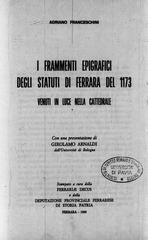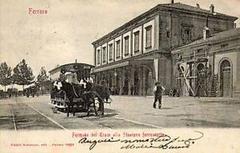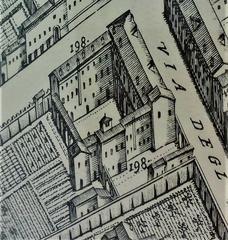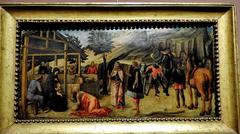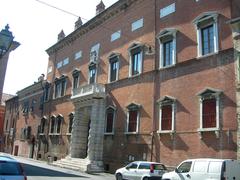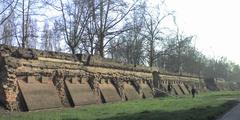National Archaeological Museum of Ferrara: Complete Guide to Visiting Hours, Tickets, and Historical Highlights
Date: 04/07/2025
Introduction
The National Archaeological Museum of Ferrara is a renowned cultural and historical institution housed in the magnificent Renaissance Palazzo Costabili. As the custodian of thousands of artifacts from the ancient Etruscan city of Spina and the wider Po Valley, the museum is a gateway to understanding the region’s ancient past and its profound Mediterranean connections. Whether you are an archaeology enthusiast, a student of history, or a cultural traveler, this guide covers everything you need to know for a memorable visit—including the museum’s history, major collections, practical visitor information, and travel tips (Google Arts & Culture, Lonely Planet, Inferrara.it).
Table of Contents
- Origins and History of the Museum
- Setting: Palazzo Costabili
- Archaeological Significance and Collection Highlights
- Museum Development and Visitor Experience
- Visiting Hours, Tickets, and Facilities
- Getting There and Accessibility
- Nearby Attractions
- Must-See Exhibits
- FAQ
- Travel Tips and Practical Information
- Conclusion and Further Resources
Origins and History of the Museum
The National Archaeological Museum of Ferrara was established in 1935 to house the extraordinary discoveries from the Etruscan city of Spina. Located near the Po River delta, Spina flourished from the 6th to the 3rd centuries BCE as a major emporium facilitating trade between Etruscans, Greeks, and other Mediterranean peoples. The city’s necropolis, uncovered in the 20th century, revealed over 4,000 tombs filled with ceramics, jewelry, and daily objects, forming the core of the museum’s internationally recognized collection (Google Arts & Culture, Lonely Planet).
Setting: Palazzo Costabili
The museum is set within the Renaissance Palazzo Costabili, also known as the “Palazzo di Ludovico il Moro.” Designed by Biagio Rossetti in the early 16th century for Antonio Costabili, an Este family ambassador, the palace itself is a masterpiece with a beautiful central courtyard and frescoes by Garofalo and Dosso Dossi. The choice of this venue connects Ferrara’s Renaissance heritage with its ancient roots, offering visitors a unique dual experience of art and archaeology (Inferrara.it).
Archaeological Significance and Collection Highlights
Etruscan City of Spina
Spina’s archaeological finds document a cosmopolitan society influenced by both Etruscan and Greek cultures. The museum’s collections illuminate daily life, funerary customs, and the city’s pivotal role as a cultural and commercial crossroads.
Major Collection Highlights
- Greek Ceramics: One of the largest collections of Attic red-figure vases outside Greece, depicting mythological scenes and symposium rituals (Lonely Planet).
- Jewelry and Metalwork: The famed Hall of Gold Jewellery (“Sala degli Ori”) showcases exquisite Etruscan goldsmithing, including necklaces, earrings, and fibulae.
- Glass and Amber: Phoenician and Rhodian glassware and amber objects highlight Spina’s extensive trade networks.
- Roman Pirogues: Two rare dugout canoes from the late Roman period illustrate ancient river transport methods (Lonely Planet).
- Bronze Artifacts and Everyday Items: Candelabras, tripods, and domestic utensils reveal daily and ritual life.
- Writing and Epigraphy: Inscriptions and tablets document the development of writing and literacy.
Museum Development and Visitor Experience
The museum has continually modernized its exhibits through multimedia displays, interactive touchscreens, and tactile experiences to engage visitors of all ages and abilities. Educational programs, guided tours, and special events further enhance the visitor experience, making ancient history accessible and engaging (Google Arts & Culture).
Visiting Hours, Tickets, and Facilities
- Location: Via XX Settembre 122, Ferrara, Italy
- Opening Hours:
- Tuesday to Sunday: 9:00 AM–7:30 PM (last admission at 6:45 PM)
- Closed on Mondays and select public holidays (Inferrara.it)
- Tickets:
- Adults: €8
- Reduced (EU citizens 18–25): €4
- Children under 18: Free
- Special rates for groups, residents, and on the first Sunday of the month
- Tickets available online or at the museum
- Guided Tours: Offered in Italian and English; group tours by reservation (additional fees may apply)
- Facilities:
- Audioguides in Italian and English
- Educational workshops and temporary exhibitions
- Cloakroom, museum shop, accessible restrooms
- No on-site café, but several are nearby
Getting There and Accessibility
- By Foot: Short walk from Ferrara’s UNESCO-listed Renaissance city center
- By Public Transit: Several bus lines stop nearby; bus No. 2 runs from Ferrara train station
- By Car: Parking is available within walking distance (watch for ZTL restricted zones)
- By Bicycle: Ferrara is Italy’s “City of Bicycles”—racks available at the museum
Accessibility Features:
- Full wheelchair access (ramps, elevators)
- Tactile routes and Braille texts for visually impaired visitors
- Accessible restrooms
- Guide dogs and service animals welcome
Nearby Attractions
Combine your museum visit with Ferrara’s other historical and cultural sites:
- Este Castle (Castello Estense)
- Palazzo dei Diamanti
- Ferrara Cathedral (Cattedrale di San Giorgio)
- Jewish Quarter and Medieval Old Town
Must-See Exhibits
- Attic Symposium Vases: Exceptional Greek pottery, including kraters and amphorae
- Hall of Gold Jewellery: Masterpieces of Etruscan goldsmithing, displayed with support from Bulgari
- Monohull Boats (Pirogues): Rare Roman-era river vessels
- Funerary Reconstructions: Insight into Etruscan burial customs
- Renaissance Frescoes: Works by Garofalo and Dosso Dossi, reflecting Ferrara’s artistic heritage
FAQ
Q: What are the museum’s opening hours?
A: Tuesday to Sunday, 9:00 AM–7:30 PM; closed on Mondays.
Q: How much do tickets cost?
A: Adults €8, reduced €4 for EU citizens 18–25, free for children under 18; discounts and free entry on select days.
Q: Are guided tours available?
A: Yes, in Italian and English. Group tours should be booked in advance.
Q: Is the museum accessible?
A: Fully accessible, with specialized routes for visually impaired visitors and accessible restrooms.
Q: Can I take photographs?
A: Non-flash personal photography is permitted; some areas may have restrictions.
Q: Are there educational programs?
A: Yes, including workshops for children and school groups.
Travel Tips and Practical Information
- Book tickets online during peak seasons to avoid queues.
- Visit on weekday mornings or late afternoons for a quieter experience.
- Allocate 1.5–2 hours for the main collection; more if joining a guided tour or workshop.
- Exhibit labels are primarily in Italian; English translations and brochures are available.
- Combine your visit with Ferrara’s other landmarks for a full cultural experience.
- The museum is fully indoors—ideal for inclement weather.
- Family-friendly amenities, strollers allowed (some areas narrow).
- Stay updated on health and safety measures (Visit Ferrara).
Conclusion and Further Resources
The National Archaeological Museum of Ferrara is an essential destination for anyone interested in Italy’s ancient history, Etruscan civilization, and Renaissance art. Its world-class collections, engaging exhibitions, and accessibility make it a highlight of the city’s cultural landscape. To plan your visit, consult the official museum website, take advantage of guided tours, and explore Ferrara’s other remarkable sites.
For more travel inspiration and updates, download the Audiala app, follow us on social media, and browse related articles on our website.
